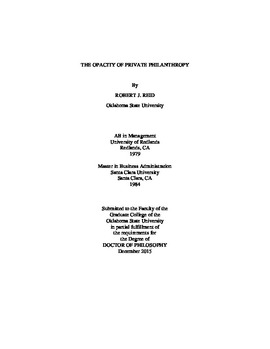| dc.contributor.advisor | Mason, Marlys J. | |
| dc.contributor.author | Reid, Robert J. | |
| dc.date.accessioned | 2016-09-29T18:46:27Z | |
| dc.date.available | 2016-09-29T18:46:27Z | |
| dc.date.issued | 2015-12 | |
| dc.identifier.uri | https://hdl.handle.net/11244/45378 | |
| dc.description.abstract | Calls for greater transparency among corporations and social institutions continue to grow in the literature. Many contend that greater transparency is needed to reduce potential for wrong doing and enhance the capacity of interested outsiders to protect the public's interests. Yet, transparency is not a cost free objective, there are consequences to imposed transparency. This research contributes to the opacity and transparency literature by probing for a deeper understanding of organizational and environmental factors that lead to opaque practices, exploring both negative and positive outcomes of opacity and investigating practices that can help reduce adverse effects of opacity between collaborating entities. Private philanthropy presented an interesting sector for studying opacity and its potential consequences, including potential for public benefits. Researchers have expressed concerns about private philanthropy's systematic lack of transparency and external accountability, which is further exacerbated by effects of disparate power. The private foundation literature is critical of private philanthropy conducting its affairs as an unchecked, but powerful secret society. Concerns expressed about a lack of transparency and disparate power among private foundations seem understandable given that they have private control over large sums of tax-advantaged funds. However, researchers have neither explored nor defined the nature of opaqueness in private philanthropy. The privacy and transparency literature suggests that transparency can impose additional costs, impede productivity and stymie innovation. This research resulted in a deeper understanding of the nature of opaque foundation practices, discovered that opacity can result in beneficial outcomes and identified strategies foundations and grantees successfully use in overcoming challenges related to opacity and coexisting disparate power. | |
| dc.format | application/pdf | |
| dc.language | en_US | |
| dc.rights | Copyright is held by the author who has granted the Oklahoma State University Library the non-exclusive right to share this material in its institutional repository. Contact Digital Library Services at lib-dls@okstate.edu or 405-744-9161 for the permission policy on the use, reproduction or distribution of this material. | |
| dc.title | Opacity of private philanthropy | |
| dc.contributor.committeeMember | White, Margaret A. | |
| dc.contributor.committeeMember | Wiener, Joshua L. | |
| dc.contributor.committeeMember | Brown, Tom J. | |
| osu.filename | Reid_okstate_0664D_14270.pdf | |
| osu.accesstype | Open Access | |
| dc.type.genre | Dissertation | |
| dc.type.material | Text | |
| thesis.degree.discipline | Business Administration | |
| thesis.degree.grantor | Oklahoma State University | |
